Introduction
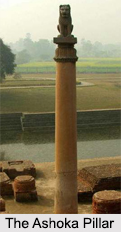 Sarnath is the place where Lord Buddha delivered his first sermon after attaining enlightenment. King Ashoka, who spread Buddha`s message of love and compassion throughout his vast empire, visited Sarnath around 234 BC and erected a `Stupa` and a pillar there. Several Buddhist structures were constructed at Sarnath between the 3rd century BC and 11th century AD and today the place represents most important ruins amongst places on the Buddhist trail.
Sarnath is the place where Lord Buddha delivered his first sermon after attaining enlightenment. King Ashoka, who spread Buddha`s message of love and compassion throughout his vast empire, visited Sarnath around 234 BC and erected a `Stupa` and a pillar there. Several Buddhist structures were constructed at Sarnath between the 3rd century BC and 11th century AD and today the place represents most important ruins amongst places on the Buddhist trail.
Sarnath is located 10 kilometres away from the holy city Varanasi and is an exceedingly tranquil place. The ruins, the temple and the museum add the value to Sarnath and all within walking distance. The deer park in Sarnath is where Gautama Buddha taught the Dharma and where the Buddhist Sangha came into survival during the enlightenment of Kondanna.
History of Sarnath
Buddha after accomplishing enlightenment at Bodh Gaya came to Sarnath and delivered his first address to 5 disciples namely - Kaundinya, Bashpa, Bhadrika, Mahanaman and Ashvajit for saving civilization. While travelling to Sarnath, Gautama Buddha had no money through which to pay the ferryman to cross the Ganges, so he crossed it during the air. Buddha consequently also spent his first rainy season at Sarnath at the Mulagandhakuti. Earlier Sarnath has been known as Mrigadava. The Sangha had developed to 60 in number and Buddha sent them out in all directions to travel without help and teach the Dharma. All 60 monks were Arahants.
Buddha`s first speech, delivered at Sarnath is known in Pali as the "Dhammacakkhapavathana Sutta". Buddhism increased in Sarnath because of the support of kings and prosperous merchants based in near Varanasi. By the 3rd century, Sarnath had become a significant centre for the arts, which reached its peak in the Gupta period. When Hsuan Tsang visited from China in the 7th century, he found 30 monasteries and 3000 monks living at Sarnath. The existence of images of Heruka and Tara specify the Vajrayana of Buddhism which was also exercised there. At the conclusion of the 12th century, Sarnath was bagged by Turkish Muslims. The place was afterwards sealed for building materials and has remained in ruins until the present day. 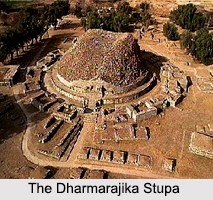
Different Attractions of Sarnath
Every bit of of the antique buildings and structures at Sarnath were damaged or destroyed by the Turks. There are some major attractions in Sarnath and these are as follows:
The Dharmarajika Stupa: This is the earliest of the remains here at Sarnath, built on Mauryan period attributed to the Emperor Ashoka the great. The Dharmarajika Stupa was expanded and enlarged several times up to 12th century AD. The structure was destroyed by repeated invasions and negligence. What is found today is the result of repeated effort of reconstruction.
The Chaukhandi Stupa: Chaukhandi is the first monument encountered by the visitors as they enter Sarnath. It is a lofty mound of brick, a structure whose square edifice is surrounded by an octagonal tower. This structure is also said to be raised by Emperor Ashoka.
The Dhameka Stupa: This is the most conspicuous structure at Sarnath. Colonel Cunningham bore a shaft from the top centre of the stupa and discovered a stone tablet on which an inscription is written with the word `Dhameka`, which mentions that this is the spot where Buddha delivered his first sermon. Dhamekha seems to be a distorted form of Dharma Chakra, which means turning the wheel of the Dharma.
The Ashoka Pillar: The Ashoka pillar is extremely important because on top of the pillar there used to be a statue of four lions holding up a wheel, which is national sign of India now. The wheel stands for `Dharma`. The pillar is broken now and the `Lion capital of Ashoka` is in display at Sarnath museum, which consists of a canopy representing an inverted bell-shaped lotus flower, a short cylindrical abacus where alternate four 24-spoked Dharma wheels with four animals (an elephant, a bull, a horse, a lion in this order) and four lions facing the four cardinal directions.
The Mulagandha Kuti Vihar: It is the modern temple erected by the Mahabodhi Society. It has excellent frescoes by Kosetsu Nosu who is famous Japanist painter. Several Buddhist relics are also excavated here. On Buddha Purnima, the birth ceremony of Buddha, relics of Buddha are taken out in procession. The archaeological museum at Sarnath houses several Buddhist sculpture and relics, also a rich collection of Buddhist manuscript and writings.
Sarnath Archaeological Museum: The grand lion wealth which topped the pillar and survived its 45 base drop to the land is on exhibit at the Sarnath Archaeological Museum. The museum is also a dwelling for some of the supreme treasures of Indian Buddhist art as well as nearly 300 images.
>History of Sarnath
Buddha after accomplishing enlightenment at Bodh Gaya came to Sarnath and delivered his first address to 5 disciples namely - Kaundinya, Bashpa, Bhadrika, Mahanaman and Ashvajit for saving civilization. While travelling to Sarnath, Gautama Buddha had no money through which to pay the ferryman to cross the Ganges, so he crossed it during the air. Buddha consequently also spent his first rainy season at Sarnath at the Mulagandhakuti. Earlier Sarnath has been known as Mrigadava. The Sangha had developed to 60 in number and Buddha sent them out in all directions to travel without help and teach the Dharma. All 60 monks were Arahants.
Buddha`s first speech, delivered at Sarnath is known in Pali as the "Dhammacakkhapavathana Sutta". Buddhism increased in Sarnath because of the support of kings and prosperous merchants based in near Varanasi. By the 3rd century, Sarnath had become a significant centre for the arts, which reached its peak in the Gupta period. When Hsuan Tsang visited from China in the 7th century, he found 30 monasteries and 3000 monks living at Sarnath. The existence of images of Heruka and Tara specify the Vajrayana of Buddhism which was also exercised there. At the conclusion of the 12th century, Sarnath was bagged by Turkish Muslims. The place was afterwards sealed for building materials and has remained in ruins until the present day. 
Different Attractions of Sarnath
Every bit of of the antique buildings and structures at Sarnath were damaged or destroyed by the Turks. There are some major attractions in Sarnath and these are as follows:
The Dharmarajika Stupa: This is the earliest of the remains here at Sarnath, built on Mauryan period attributed to the Emperor Ashoka the great. The Dharmarajika Stupa was expanded and enlarged several times up to 12th century AD. The structure was destroyed by repeated invasions and negligence. What is found today is the result of repeated effort of reconstruction.
The Chaukhandi Stupa: Chaukhandi is the first monument encountered by the visitors as they enter Sarnath. It is a lofty mound of brick, a structure whose square edifice is surrounded by an octagonal tower. This structure is also said to be raised by Emperor Ashoka.
The Dhameka Stupa: This is the most conspicuous structure at Sarnath. Colonel Cunningham bore a shaft from the top centre of the stupa and discovered a stone tablet on which an inscription is written with the word `Dhameka`, which mentions that this is the spot where Buddha delivered his first sermon. Dhamekha seems to be a distorted form of Dharma Chakra, which means turning the wheel of the Dharma.
The Ashoka Pillar: The Ashoka pillar is extremely important because on top of the pillar there used to be a statue of four lions holding up a wheel, which is national sign of India now. The wheel stands for `Dharma`. The pillar is broken now and the `Lion capital of Ashoka` is in display at Sarnath museum, which consists of a canopy representing an inverted bell-shaped lotus flower, a short cylindrical abacus where alternate four 24-spoked Dharma wheels with four animals (an elephant, a bull, a horse, a lion in this order) and four lions facing the four cardinal directions.
The Mulagandha Kuti Vihar: It is the modern temple erected by the Mahabodhi Society. It has excellent frescoes by Kosetsu Nosu who is famous Japanist painter. Several Buddhist relics are also excavated here. On Buddha Purnima, the birth ceremony of Buddha, relics of Buddha are taken out in procession. The archaeological museum at Sarnath houses several Buddhist sculpture and relics, also a rich collection of Buddhist manuscript and writings.
Sarnath Archaeological Museum: The grand lion wealth which topped the pillar and survived its 45 base drop to the land is on exhibit at the Sarnath Archaeological Museum. The museum is also a dwelling for some of the supreme treasures of Indian Buddhist art as well as nearly 300 images.
Sculpture of Sarnath
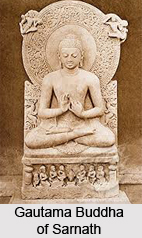 During the first three centuries of the contemporary era, the workshops of Gandhara and Mathura had created virtually all the surviving freestanding stone sculptures, together with style. A handful of works, predominately yaksis, in styles allied to Mathura, were found as Far East as Patna. For images of the Buddha, both standing and seated, exports from Mathura itself were relied upon. The Kanoria Parsvanatha stele, from Patna, was commonly held to be from the late 4th century, and the fragmental inscription of Rajgir, the seated Neminatha, may be attributed to the reign of Chandragupta II (c.377-414), due to the manner in which the lower garment of the standing attendee figure terminates just above the knees, with four audacious ripples descending between the legs. Both manifests the preliminary stages of a style which had climaxed during the post-Gupta Buddhas of Nalanda, but not, interestingly enough, the great Gupta Buddhas of Sarnath, confessedly further to the west. The legendary seated Buddha from Bodh Gaya, dated in the year 64 of an anonymous king who presumably reigned within the Gupta period (i.e. 320 + 64 = A.D. 384), is one of the central pieces in the long history of Indian sculpture. It was long assumed to be an import from Mathura, because the body was in the same position as the Katra-type Buddhas created there, the pleats of the robe were crowded together in a likewise manner, and its throbs with their immense physical vivacity. But the head was rather unusual- the face was threatening, heavy lidded, the eyes concentrated the end of the nose- an over-the-top controlling evocation of the Buddha as the great yogi. According to Stella Kramrisch`s words, it is `the first image in India which by its form signifies what its name implies`.
During the first three centuries of the contemporary era, the workshops of Gandhara and Mathura had created virtually all the surviving freestanding stone sculptures, together with style. A handful of works, predominately yaksis, in styles allied to Mathura, were found as Far East as Patna. For images of the Buddha, both standing and seated, exports from Mathura itself were relied upon. The Kanoria Parsvanatha stele, from Patna, was commonly held to be from the late 4th century, and the fragmental inscription of Rajgir, the seated Neminatha, may be attributed to the reign of Chandragupta II (c.377-414), due to the manner in which the lower garment of the standing attendee figure terminates just above the knees, with four audacious ripples descending between the legs. Both manifests the preliminary stages of a style which had climaxed during the post-Gupta Buddhas of Nalanda, but not, interestingly enough, the great Gupta Buddhas of Sarnath, confessedly further to the west. The legendary seated Buddha from Bodh Gaya, dated in the year 64 of an anonymous king who presumably reigned within the Gupta period (i.e. 320 + 64 = A.D. 384), is one of the central pieces in the long history of Indian sculpture. It was long assumed to be an import from Mathura, because the body was in the same position as the Katra-type Buddhas created there, the pleats of the robe were crowded together in a likewise manner, and its throbs with their immense physical vivacity. But the head was rather unusual- the face was threatening, heavy lidded, the eyes concentrated the end of the nose- an over-the-top controlling evocation of the Buddha as the great yogi. According to Stella Kramrisch`s words, it is `the first image in India which by its form signifies what its name implies`.
The seated Buddha from Mankuwar in eastern Uttar Pradesh, dated 429, exhibits the influence of the comparatively contemporary styles in Mathura, with its low base, assuming a central chakra and two frontal-facing lions. The face, though more circular, also depicts some of the rigorousness of the 5th century Mathura Buddhas. Undoubtedly, the supreme Hindu image of the Gupta period thus far known from the eastern Madhyadesa, is the colossal 6ft. Krishna Govardhana (Krishna holding up the Guardian Mountain) from Varanasi, now preserved in Bharat Kala Bhavan. The arms have been reestablished, not unproductively, though they are possibly a shade too gigantic. The young prince (kumara) Krishna wore the archetypal pair of tiger`s claws, (vyiighra nakha) on his necklace, a low crown and three locks of hair (trisikhin), the customary marks of Kartikeya (Skanda) and of the Bodhisattva Mafijusri, all exhibited as kumaras. The lower torso and stomach possesses the Sarnath sensitivity, a hardly discernible roll of flesh bulging out above the squeezing top of the dhoti. The large round face, and the not very deep set eyes are still resonant of Udayagiri.
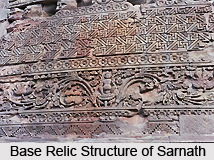 One of the most endearing Indian sculptures is the Gadhwa `lintel` frieze, its charm possibly heightened by the doubtfulness environing its purpose and themes. In the midpoint of the long narrow carving, stands Vishnu Visvarupa, in one of his emanatory forms. At one end stands Surya, the sun god, in his chariot on the backdrop of a circular disc, while at the other end stands Chandra (the moon), seated with his consort on a hemispherical moon. Towards the left, a long parade of musicians, young girls and others carrying food, curves its way, behind a figure kneeling at the feet of Vishnu, a sunshade referring high rank held over his head. On the opposite side, with additional gifts of food, another parade approaches, including a burly soldier with a hefty amount of hair, carrying a sword, tallying a Nepalese kukri. At its head is a statuette, also fêted by a sunshade. They are adjoined by two others, emerging from a building, plausibly a dharmaiiilii, or pilgrim`s hall, in which bending figurines are being fed by women, wearing a distinguishing head-cover, that comes down under the chin. The Gadhwa lintel is discerned by the nonexistence of wholly ornamental elements (no jewellery even is present) and by the dexterous metrical insertion and variety of stances of the procession- work of a superior sculptor `unusually adept in representing three-dimensional poses, with an exceptionally slender canon of proportions`. On stylistic justifications, the lintel would seem to belong to the latter part of the reign of Kumaragupta (C. 414-55), whose inscriptions appear at the place with others of Gupta date. It exemplifies the peak of Gupta narrative relief.
One of the most endearing Indian sculptures is the Gadhwa `lintel` frieze, its charm possibly heightened by the doubtfulness environing its purpose and themes. In the midpoint of the long narrow carving, stands Vishnu Visvarupa, in one of his emanatory forms. At one end stands Surya, the sun god, in his chariot on the backdrop of a circular disc, while at the other end stands Chandra (the moon), seated with his consort on a hemispherical moon. Towards the left, a long parade of musicians, young girls and others carrying food, curves its way, behind a figure kneeling at the feet of Vishnu, a sunshade referring high rank held over his head. On the opposite side, with additional gifts of food, another parade approaches, including a burly soldier with a hefty amount of hair, carrying a sword, tallying a Nepalese kukri. At its head is a statuette, also fêted by a sunshade. They are adjoined by two others, emerging from a building, plausibly a dharmaiiilii, or pilgrim`s hall, in which bending figurines are being fed by women, wearing a distinguishing head-cover, that comes down under the chin. The Gadhwa lintel is discerned by the nonexistence of wholly ornamental elements (no jewellery even is present) and by the dexterous metrical insertion and variety of stances of the procession- work of a superior sculptor `unusually adept in representing three-dimensional poses, with an exceptionally slender canon of proportions`. On stylistic justifications, the lintel would seem to belong to the latter part of the reign of Kumaragupta (C. 414-55), whose inscriptions appear at the place with others of Gupta date. It exemplifies the peak of Gupta narrative relief.
Looking towards images, the Sarnath Buddhas are perhaps the biggest single triumph of the Indian sculptor. They were also the most broadly circularised and persisted to influence Buddha illustrations in eastern India, and far beyond in Southeast Asia, for centuries. By a shot of honest destiny, uncommon in early Indian history, dated examples exist, establishing that they were a comparatively late improvement- not before the 3rd quarter of the 5th century. Nothing seemed to announce these debonaire creations of a virtually inimitable perfection- they exhibited a total break at last, from the plastic concepts of Mathura, and the handling of the human body would hereafter prevail in eastern India.
The Buddhas stand in very trivial dehanchement. They wear the customary lower garment, covered with the sarhghat, specified only by the lines delineating the edges, that body consequently is entirely unveiled, excluding the sexual organs. The large, brilliantly adorned haloes intimately tally with the contemporary Mathura standing Buddhas; the faces on the other hand are 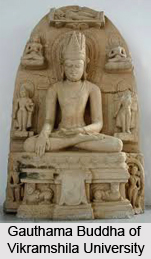 those of beings who have surpassed the world of samsara and exist in a state of complete devout consciousness- a quality, which describes the complete image. Perfectly balanced, the bodies are not realistically treated, but accomplish an approximately marvellous harmony of interflowing planes. They are among the world`s greatest classic accomplishments- classic both in being, consequently unmatchable and in historical sense, in deciding the form, which the Buddha image was to take for centuries.
those of beings who have surpassed the world of samsara and exist in a state of complete devout consciousness- a quality, which describes the complete image. Perfectly balanced, the bodies are not realistically treated, but accomplish an approximately marvellous harmony of interflowing planes. They are among the world`s greatest classic accomplishments- classic both in being, consequently unmatchable and in historical sense, in deciding the form, which the Buddha image was to take for centuries.
In the greater part of the Sarnath Buddha, Sakyamuni is depicted seated, his hands in the mudra of dharmacakrapravartaa, `setting the wheel of law in motion`, i.e. preaching the First Sermon in Deer Park, Sarnath- an exceedingly apt theme. On the bases, the deer looks at a chakra. Most of the Bodhisattva images are from a later period, but one or two have managed to outlive from this period. Sarnath also had created narrative sculptures of a lofty order, depicting events from Buddha`s life. In the elevated Gupta style, they however have a somewhat quality compared, for example, to the Gadhwa lintel- maybe on account of the conventional subject matter.
Buddhist Sculpture at Sarnath
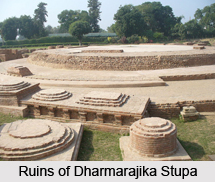 Sarnath is one of the most beautiful sites in the world & sacred where the Buddha delivered his first sermon, which was the introduction of Buddhism. The Lion Capital on top of one of pillar, which is recognized as the National Emblem of India, is from Sarnath. Along with it, several other Buddhist structures were raised at Sarnath that represents today the most expansive ruins amongst places on the Buddhist trail.
Sarnath is one of the most beautiful sites in the world & sacred where the Buddha delivered his first sermon, which was the introduction of Buddhism. The Lion Capital on top of one of pillar, which is recognized as the National Emblem of India, is from Sarnath. Along with it, several other Buddhist structures were raised at Sarnath that represents today the most expansive ruins amongst places on the Buddhist trail.
The main structure of the place has been enclosed and marked with the presence of a labyrinth or complex structure of monasteries that are in half-ruined condition stupas. But from all, the building that attracts the attention of viewer is the Dhamek Stupa. Dhamekh Stupa is known for particular significance at Sarnath as it signifies the "seat of the holy Buddha", after he proclaimed his faith. Believed to be constructed 5th to 6th century & significantly shows the spot where the Buddha gave his first sermon. It is a cylindrical tower of around 30 meters high with a solid structure. But the sculptural beauty is maintained with all the architectural techniques. The trunk of the stupa is decorated using panels carved with geometric and floral designs.
Another ruined stupa of named the Dharmarajika Stupa is believed to have been built by Emperor Ashoka. It is situated at the west of Dhamek Stupa & built in third century BC. And in its architectural settings, within its solid hemispherical mound a casket of funerary relics was found.
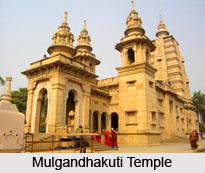
Even the structure of Mulgandhakuti temple, the chief shrine of the Buddha, about 61mtrs high was erected during the Gupta period in the 4th-6th century A.D. this place is of a lot of significance because when Buddha was in Sarnath, he had rested and meditated here.
The Ashoka Pillar commemorates King Ashoka`s visit in Sarnath, who laid the foundation of the Buddhist Sangha here. The Lion Capital of Sarnath is certainly the excellent specimen of Mauryan art. The sculptures in stone pillars found at Sarnath or Allahabad, Merut, Kausambi, Sankisa and Varanasi advocates the excellence art of Mauryan.
Lion Capital at Sarnath
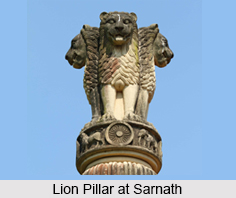 The Lion Capital of Ashoka is a sculpture of four Asiatic lions standing back to back, on an elaborate base that includes other animals as well. A graphic representation of it was adopted as the official Emblem of India in 1950. It was originally placed on the top of the Ashokan pillar at the Buddhist site of Sarnath built by the Emperor Ashoka, in about 250 BCE. The pillar is still standing in the same location, but the Lion Capital has been kept in the Sarnath Museum of Uttar Pradesh.
The Lion Capital of Ashoka is a sculpture of four Asiatic lions standing back to back, on an elaborate base that includes other animals as well. A graphic representation of it was adopted as the official Emblem of India in 1950. It was originally placed on the top of the Ashokan pillar at the Buddhist site of Sarnath built by the Emperor Ashoka, in about 250 BCE. The pillar is still standing in the same location, but the Lion Capital has been kept in the Sarnath Museum of Uttar Pradesh.
Formation of Lion Capital at Sarnath
Lion Capital at Sarnath was made of highly-polished sandstone and is more than two meters in height. The lion capital has been carved out from a single block of sandstone. The capital comprises four lions placed back to back on a round slab or what is called an abacus resting atop an inverted bell-like form carved like a lotus.
Wheel of Life in Lion Capital at Sarnath
Wheel of Life is one of the purest Buddhist symbols. Buddhist symbols can be seen in the entrance of almost all monasteries. This emblem is also widely depicted on Thankas or religious scrolls.
History of Lion Capital at Sarnath
Historians dated this capital to sometime around 250 B.C. On the side of the abacus are carved four animals. They are lion, elephant, bull and horse moving in a clockwise fashion. The animals are interspersed with four wheels or chakras which represent the Buddhist concept of the Wheel of Life. History records that Ashoka was a mighty king who reigned during the 3rd century B.C. He was the grandson of Emperor Chandragupta Maurya, founder of the Maurya Dynasty. Ashoka`s turning point came in the eighth year of his reign after the dreadful battle of Kalinga where thousands lost their lives and were taken in bondage. Witnessing the senseless bloodshed, Ashoka had experienced a change of heart. He then adopted as his life`s mission, the Buddhist path of righteous living and took it upon himself to spread Buddha`s teachings of peace and non-violence far and wide in his kingdom and outside it. It has been said that Ashoka had inscribed edicts about Buddha`s lessons on the right path on rock faces and pillars and the lion capital at Sarnath is one such example.
Depiction of Lion Capital at Sarnath
In Sarnath, there is a stylization in the depiction of the lions. Lion Capital at Sarnath has certain characteristics of the fierce animal that are captured artistically. Wonderful stylization has been depicted in the gaping, roaring mouths, in the wavy hair of the mane and in the curling whiskers.
Animal Depiction of Lion Capital at Sarnath
Regarding the animal motifs in Sarnath, it can be said that compared to the majesty of the lion, the animals on the abacus are done with great naturalistic energy. The inverted bull represents a stylized carving. The stylized lion may have been Persian in influence, but the bulls, elephants, geese were naturalistic and very Indian in their treatment.



















